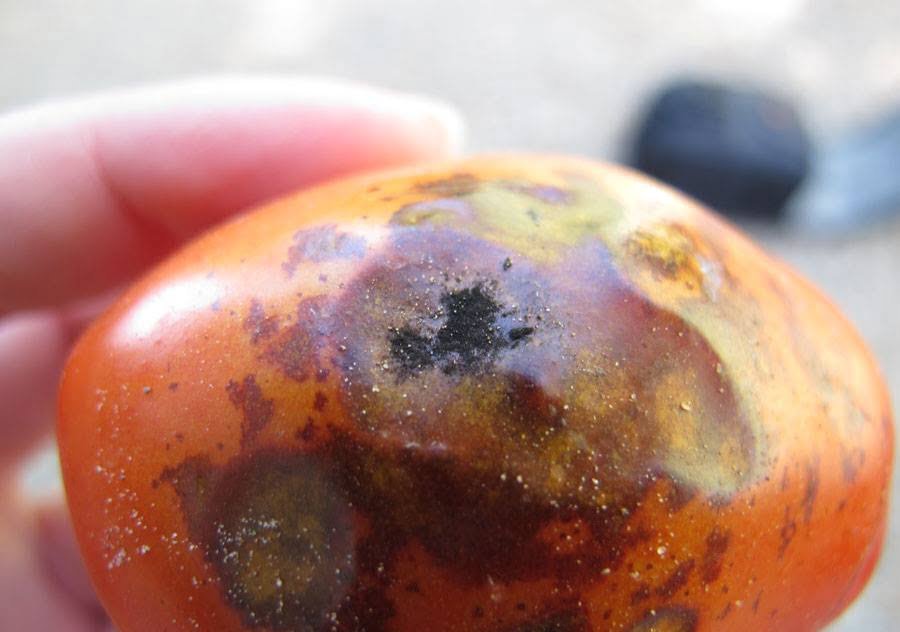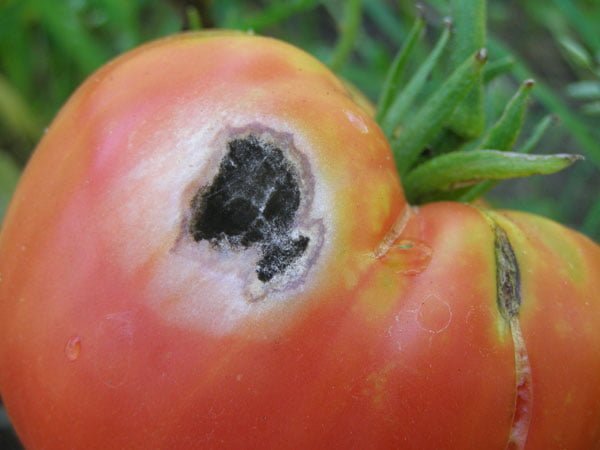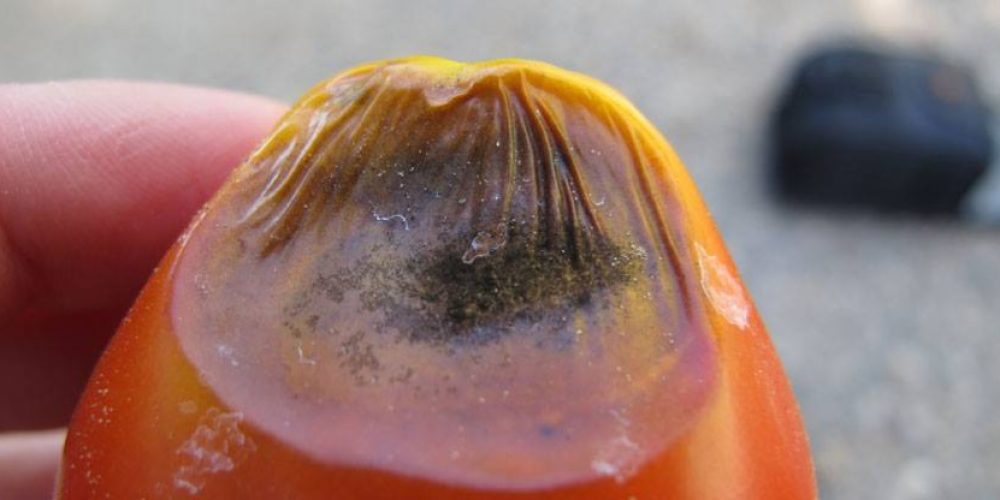Table of contents of the article
ToggleBlack mold in tomatoes is a fungal disease that attacks tomato fruits and affects their quality. In this article on your website, World of Plants, we explain methods of prevention and control.
What is black mold disease in tomatoes?
Black mold disease in tomatoes. The cause of the disease is the fungus Alternaria solani, Alternaria alternata. The fungus that causes the disease spreads in warm, humid weather. The fungus that causes the disease infects ripe fruits, and spots appear on the fruits that are pale to dark brown in color, affecting the tissues of the fruit’s skin, especially at the neck of the fruit. It spreads to the seed cavity and spots appear, and the irregular, deformed surface of the fruits can lead to the appearance of characteristic black, smooth rots. Then other fungi appear that increase the infection.
Black rot disease cycle in tomatoes
Black mold can appear in the field late in the season after rain or dew. Fungal spores require 3 to 5 hours of moisture to germinate.
It also affects the leaves in the form of spots on the lower leaves and moves to the top of the plant, takes on a circular shape and withers, and this leads to a reduction in production in terms of the number and size of fruits.
Treatment is by regulating irrigation, ventilating the greenhouse, accelerating the harvesting process, and treating with specialized fungicides recommended by the Ministry of Agriculture, including Scor, a systemic fungicide at a rate of 50 cm3 per 100 liters of water.


Symptoms and damage of black mold in tomatoes
- Spots ranging from superficial depressions to sunken brown to black spots may extend even into the fruit gaps.
- 7-shaped spots may form, often forming at the scars through which the fruits connect to the stem
Alternaria alternate causes this fungus in tomatoes. Tomatoes are infected with two other diseases caused by fungi belonging to the genus Alternaria that can be mixed with black mold disease, which are: early blight caused by the fungus A solani. Alternaria stem canker caused by A alternata f.sp. Lucopersici fungi infect leaves, stems, and green fruits, but neither of them can infect ripe fruits
Symptoms of black mold infection in tomatoes
- Green fruits may sometimes be infected, but the infection remains confined to a very limited number of skin cells, and disease spots do not form until the fruits are ripe.
- The diseased spots that appear on ripe fruits vary between small, superficial, brown spots to many circular, sunken black spots, in which the decomposition extends internally, reaching the walls of the housings, and then to the housings themselves. In the advanced stages of infection, the fungus produces in the warm, humid weather the growth of black spores. In these sunken spots, while germs rarely form in superficial spots
- It is noteworthy that the infection of the fruits often remains latent, and the disease spots do not develop and form until the fruits are exposed to cold damage.
- Tomato varieties differ in their susceptibility to this disease due to their different response to post-harvest heat treatment, which leads to partial removal of the natural wax layer that covers the fruits, to low temperatures causing cold damage, and to the fungus penetrating natural fruits faster than in mutant fruits.
Presence of fungi and appropriate conditions for the occurrence of black mold disease in tomatoes
- The fungus A. alternate is considered one of the most abundant fungi in nature, as it lives and reproduces on plant remains in the soil whenever moisture is available in it. It is also found on old leaves in tomato fields before the fruits ripen. This fungus is a weak pathogenic organism, as it does not attack static tissues or Those that have reached the senescent stage, so it does not infect tomato fruits until after they are ripe
- The disease appears in the field after rain or dew at the end of the growing season. A water film must be present on the surface of the fruits for a period of 3-5 hours. At least for the fungal spores to germinate, and infection occurs when the fungus directly penetrates the skin of the fruit. The disease can spread epidemically in tomato fields within 4-5 days following a period of rain. In the absence of rain, fruits that are covered by vegetative growth rarely become infected, because the dew does not condense on them. Fruits unless they are completely exposed.
- Although the fungus can directly penetrate the skin of the fruit, wounding the fruit leads to an increased incidence of the disease. A circle of diseased spots is often observed on the shoulders of the fruit around its neck. This is due to the exposure of the shoulders of the fruit - more than any other part of the fruit - To pressures and frictions that cause mechanical damage.
- The infection increases severely in fruits that are stored at a temperature below 5°C for more than a few days, even before they show any symptoms of cold damage.
Methods of control against black mold disease in tomatoes
To combat the disease, the following must be taken into account:
- Cultivation of varieties with compact vegetative growth that prevents the formation of honeydew on the fruits.
- Harvest in the early stages of fruit maturity
- . Preventive spraying with appropriate fungicides approximately before the expected harvest date
5-6 weeks, with repeated spraying every about 10 days, but spraying with pesticides less than two weeks before harvest is not useful, and it is one of the pesticides that can be used to combat the disease. Avoid exposing the fruits after harvest to either very high or very low temperatures, which are conditions that cause the fruits to lose their natural resistance to the fungus that causes the disease. If the fruits are exposed to low temperatures in the field before harvesting, their harvest must be accelerated and their ripening should be accelerated if they are still green. Temperature: 18°C - 22°C) and offered for sale in nearby markets.
Prevention and treatment against black mold disease in tomatoes
- Avoid situations that lead to injuries to the fruits, whether caused by insects or by humans.
- Follow agricultural methods that keep fruits from coming into contact with the soil.
- Use appropriate fungicides such as:
- Ridomil/Plus at a rate of 150 g/100 liters of water.
- Copperointrakol at a rate of 350 g/100 liters of water.
- Cultivation of varieties with hard fruits.
- Use resistant varieties.
In conclusion, we would like to note that we, at the world of plants website, offer you all the necessary services in the world of plants, we provide all farmers and those interested in plants with three main services::-
- Artificial intelligence consulting service to help you identify diseases that affect plants and how to deal with them.
- Blog about plants, plant diseases and care of various crops ... You are currently browsing one of her articles right now.
- An application that provides agricultural consultations to clients, as well as a service for imaging diseases and knowing their treatment for free – Click to download the Android version from Google Play Store، Click to download the IOS version from the Apple App Store.
References
Vegetables - tomatoes - fungal diseases - black mold - agricultureegypt
Black mold on tomatoes - al-hakem
Utah State University – Black Mold




